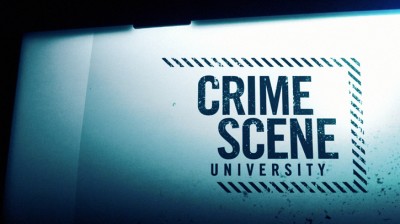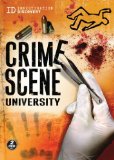| Reviews & Columns |
|
Reviews DVD TV on DVD Blu-ray 4K UHD International DVDs In Theaters Reviews by Studio Video Games Features Collector Series DVDs Easter Egg Database Interviews DVD Talk Radio Feature Articles Columns Anime Talk DVD Savant Horror DVDs The M.O.D. Squad Art House HD Talk Silent DVD
|
DVD Talk Forum |
|
|
| Resources |
|
DVD Price Search Customer Service #'s RCE Info Links |
|
Columns
|
|
|
Crime Scene University
Adapting an actual Penn State course entitled "Forensic Science 201: Crime Scene Investigation," Dr. Bob Shaler, director of the university's forensic science program and professor of biochemistry and molecular biology, supervises the dozen students, all in their late-teens and early-20s. Each show is structured like this: divided into two competing teams working different but (usually) identical crime scenes, the students must work together, budgeting their time to gather and record evidence: finger- and footprints, DNA and entomological evidence, determine bullet trajectories, etc. This eats up about half of the show's 42 1/2-minute running time.
Back at the lab, the students next analyze what they've gathered and begin to theorize what happened at each crime scene. Dr. Shaler patiently listens to their theories, and then point-by-point analyzes their accomplishments and mistakes before declaring a "winning" team that week.
Crime Scene University is far from compelling television for a number of reasons. Though Shaler clearly knows his stuff, he comes off no more or less than a typical university professor, and isn't exactly dripping with screen charisma. That said, he's far more interesting than the majority of his slack-jawed, inarticulate students, who unassertively stand around chewing gum, aimlessly waiting for someone to tell them what to do. When in the final episode Shaler invites his students to "think outside the box," to engage in some original thinking, the students' eyes glaze over and wander everywhere except in Shaler's direction, with that please-please-please-don't-call-on-me look of dread. If as the opening credits insist, these students are the future of forensic science, it looks like we're in for a lot of unsolved murders.
And yet even on a more primary level, the students just aren't interesting or particularly likeable. Perhaps if they had been introduced better, so that the viewing audience would have some sense of their individual personalities. Instead, they're just a bunch of lemmings.
The program's game show structure, pitting a Blue Team against a Gray Team, doesn't help, suggesting as it does a kind of crime scene Battle of the Network Stars. The bigger problem is that because of the way it's filmed and cut together, Crime Scene University makes for extremely passive entertainment when it could/should be engaging the audience much more than it does.
For instance, it would play a heck of a lot better if the crime scenes were plainly outlined at the beginning of each segment, maybe via overhead cameras or detailed maps. Instead, spatial relationships are totally ignored; the audience rarely has a sense of where anything is in relation to everything else - hardly desirable in a science where spatial relationships are everything.
Though TV shows like CSI - Crime Scene Investigation have been criticized for the liberties they take with real world forensic science, I was surprised that virtually every procedure discussed in these six episodes - about maggot paths, blood spatters, shoe print databases, etc. - I'd already heard about in the first few episodes of the first season of CSI. So even on an educational level, Crime Scene University is pretty thin stuff.
Video & Audio
Shot digitally, Crime Scene University's six episodes are presented in eye-pleasing 16:9 enhanced widescreen, with video and Dolby Digital stereo audio up to contemporary basic cable television standards. The shows are on two single-sided, dual-layered discs, and include optional English SDH captioning. There are no Extra Features.
Parting Thoughts
Crime Scene University isn't terrible, but gets a C-minus for not coming anywhere close to living up to its full potential as infotainment. The DVD looks just fine, but I found the show incredibly dull and recommend that you Skip It.
Film historian Stuart Galbraith IV's latest book, Japanese Cinema, is on sale now.
|
| Popular Reviews |
| Sponsored Links |
|
|
| Sponsored Links |
|
|
| Release List | Reviews | Shop | Newsletter | Forum | DVD Giveaways | Blu-Ray | Advertise |
|
Copyright 2024 DVDTalk.com All Rights Reserved. Legal Info, Privacy Policy, Terms of Use,
Manage Preferences,
Your Privacy Choices | |||||||















